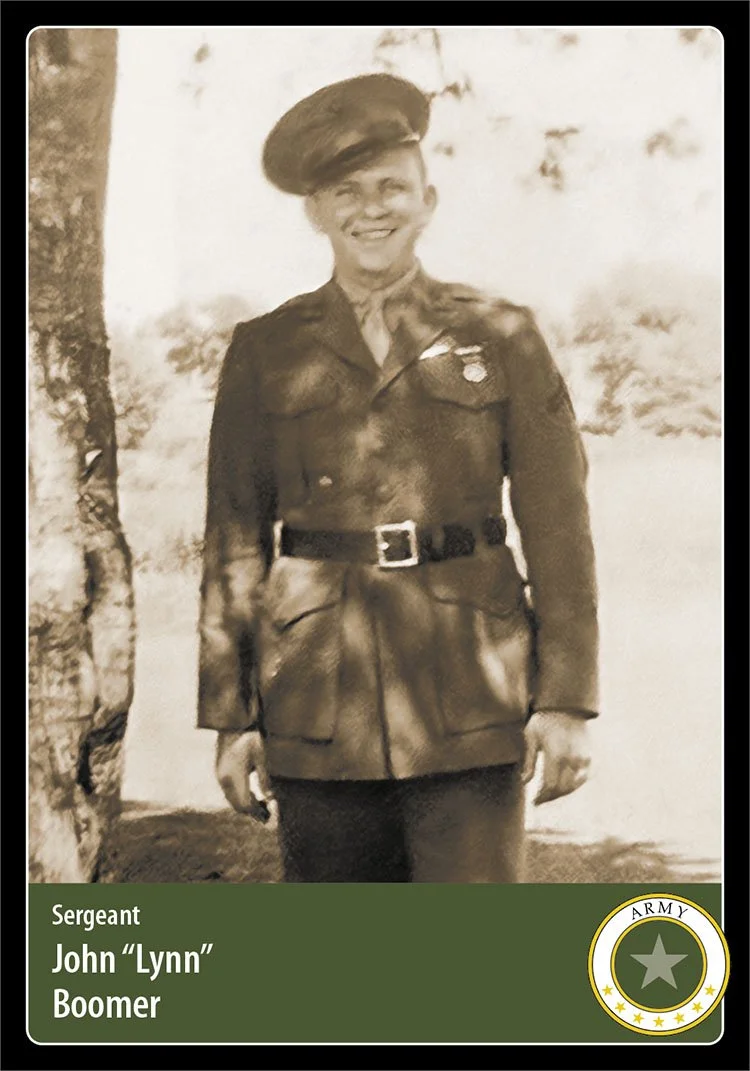Hero Card 262, Card Pack 22
Photo (digitally enhanced) provided by the family.
Hometown: Durand, IL
Branch: U.S. Army (Air Forces)
Unit: 324th Bombardment Squadron, 91st Bombardment Group, 8th Air Force
Military Honors: Air Medal, Purple Heart
Date of Sacrifice: November 23, 1942 - MIA over Bay of Biscay, 30 miles northwest of St. Nazaire, France
Age: 22
Conflict: World War II, 1939-1945
In the farm fields of Burritt Township, halfway between Durand and Rockford in northern Illinois, John “Lynn” Boomer grew up with younger sisters Beulah “Jean” and Beatrice, and younger brothers Wayne and Dwight. Their parents, Stanley and Bessie (Hurd) Boomer provided for the family by raising crops and livestock.
Serving their country was part of the Boomer family legacy. Stanley was an infantryman during World War I (1914-1918). Lynn’s paternal grandfather, Edward H. Boomer served in the Union army during the Civil War (1861-1865).
After a year of high school, Lynn took a job as a coast-to-coast truck driver.
In September 1941—less than two months before the United States officially entered WWII following the surprise attack on Pearl Harbor, Hawaii—Lynn Boomer enlisted in the Army Air Forces (the precursor to the U.S. Air Force, formalized as a separate military branch in 1947).
With war raging across the world, Lynn’s mother would hang a red and white banner in the front window, bearing four blue stars—one for each of the Boomer children serving in the military. In addition to Lynn, Wayne served in the Army and Dwight in the Marine Corps. An older half-sister, Myrna, also served in the Army. Stanley had lost his first wife, Elsie (Nowatske) in 1914.
Lynn Boomer trained at Keesler Field in Biloxi, Mississippi and later at McDill Field in Tampa, Florida. Sent to the war’s European Theater of Operations, Boomer was assigned to the 324th Bombardment Squadron, 91st Bombardment Group, 8th Air Force.
Promoted to the rank of sergeant, Boomer was trained as a waist gunner on a Boeing B-17F “Flying Fortress” heavy bomber, nicknamed Pandora’s Box (41-24503). Waist gunners manned machine guns that extended through window openings on sides of the fuselage, between the wings and tail—one defending each side of the aircraft.
According to the Army Air Corps Museum:
The primary duty of the waist gunner was to defend the aircraft against the enemy. On a B17, there were two waist gunners located directly opposite one another. This made maneuvering sometimes difficult, and until later models of the B17, frostbite was also an issue, as the waist gunners stood near open window areas. Because of this, waist gunners frequently wore heavy layers of shearling and leather protective clothing, as well as electrically heated suits. Waist gunners were also frequently responsible for checking the aircraft for damage and assisting the flight engineer with repairs if necessary.
On November 23, 1942, Pandora’s Box was part of a 10-bomber mission to destroy German U-boats harbored at St. Nazaire on the coast of German-occupied France. They’d take off from Bassingbourn, England, and cross the English Channel to strike the enemy.
In a personnel profile for the mission’s command pilot, Maj. Harold C. Smelser, the Defense POW/MIA Accounting Agency recounts the events of what would be the crew’s final flight:
On November 23, 1942, a B-17F Flying Fortress (serial number 41-24503) nicknamed “Pandora’s Box” took off from an airfield in Bassingbourn, England, with nine other aircraft on a bombing mission targeting the entrance of a German submarine base at Saint-Nazaire, France. While over the English Channel, the formation came under attack by German fighters that forced “Pandora’s Box” to abandon its approach without dropping its bombs. “Pandora’s Box” took heavy damage from the German fighters and lost its life raft while struggling to stay aloft. The aircraft's last known location was roughly five hundred feet offshore and thirty miles northwest of Saint-Nazaire. The eleven crew members aboard “Pandora’s Box” were presumed lost with the aircraft.
Allied bomber crews reported the German Luftwaffe had changed tactics to attack bombers head-on—because of the lack of forward firepower on the bombers. Of the ten B-17s dispatched by the 91st Bomb Group, none managed to bomb the target.
A Missing Air Crew Report (number 16162) submitted to the War Department adds details to the last moments of the crew’s final mission:
Ten (10) B-17’s of the 324 Bomb Sq, 91st Bomb Gp were hit by twelve (12) FW 190s just over the coast. Four (4) more FW 190s joined the attack just before the IP [Initial Point]. Five (5) enemy air craft were destroyed and one (1) damaged.
[Pandora’s Box] turned towards the sea and was followed by three (3) other B-17s. Lt. Gorman, pilot of one of the three planes following #503, followed #503 down to 2000 feet. Major Smelser, Command Pilot of this flight of bombers, waved the other planes on. A life raft could be seen hanging from the tail of #503. Lt. Gorman stated that #503 landed in the sea 30 miles northwest of St. Nazaire, France or made a forced landing on the Brest Peninsula. This A/C [aircraft] with one or more engines burning, never reached the target.
No one saw a crash. Pandora’s Box disappeared into the clouds off the coast of France and never returned to its base in Bassingbourn. Its 11 crewmembers—including Sergeant John Lynn Boomer, age 22—were listed as Missing in Action and presumed killed.
Sgt. Boomer’s name is inscribed on the Wall of the Missing at the Cambridge American Cemetery in England.
Sources
Details submitted by Mr. Lynn Boomer, SGT Boomer’s nephew
National Archives Catalog, NAID: 91173005: Missing Air Crew Report number 16162
American Air Museum in Britain: John Lynn Boomer
American Air Museum in Britain: 41-24503 Pandora’s Box
Defense POW/MIA Accounting Agency: Maj. Harold C Smelser
The Durand Gazette, Dec. 3, 1942: Believe Durand Boy is Lost
The Spokesman-Review, Nov. 20, 2005: Years later, loved ones find answers
Honor States: John Lynn Boomer
Find a Grave: Sgt John Lynn Boomer





